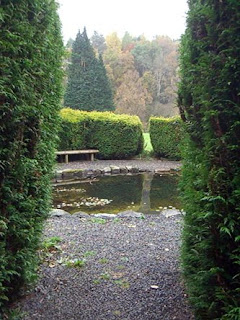A kiln cooling - listen closely and the pots quietly go ping - ping -

The demonstration today was of screen printing onto slabs. First make your screen - this one is made with emulsion from a photo (it needs a special machine to do so), and stretched on a picture frame -

Another screen printing possibility is to mix a little "medium" into the slip, and print on thick paper or fabric. That can be put on the clay, and in the firing the paper or fabric burns off, leaving the clay behind as a "print". I've brought some home to try (but first must clear off my workbench, which still has wax from the sculpture project).
You can use stamps to impress into the clay, and then fill the dips with coloured slip - and once it's dry, print with a darker colour, so the slip looks like a shadow -

Most of my glazed pieces came out of the kiln during the week. I'm trying to figure out, from my notes, what's what - this learn-by-doing method could take a long time -

Before and after - the black slip has gone quite dark with the stoneware firing, and the clear glaze gives it a nice quality -

But this is my favourite - the pins in the clay have bubbled up a treat, making a good contrast with the printed slip under a clear matte glaze on the other side. I'll use this combination again. At last, a bit of "vocabulary" for the next project!

More of the same here, in one of my "mouths of hell" - it's quite an ambiguous object -

Towards the end of the day these came out of the kiln - I need to figure out what's what -

At last I've moved on to making slabs into "little houses" (of a sort) - keeping it somewhat simple, black slip and possibly clear or white glazes later. The "stilts" from the sculpture project are making an appearance -

The sloping floors make semi-secret areas underneath -

Let's see what happens with the pins across the windows. They're from a box of office pins, nice and sturdy, I got for 10 pence many years ago; I'll be trying tacks and nails too -

It takes me quite a while to get going in class, and then at the end of the day I don't want to stop - by then I have a long mental list of what to do next. It takes actually handling the material to get the ideas going.
 The L-plates will brace the uprights and their weight will lower the centre of gravity.
The L-plates will brace the uprights and their weight will lower the centre of gravity. The stones on the bottom will also help hold it down.
The stones on the bottom will also help hold it down. But the cloth was greeted with shrieks of horror - and I immediately saw why; it looked "like a shop display" - no, we don't want that! This version is better -
But the cloth was greeted with shrieks of horror - and I immediately saw why; it looked "like a shop display" - no, we don't want that! This version is better - And, finally, out into the display area it went.
And, finally, out into the display area it went. The tape inside (hinging the corners) could have bits of this'n'that trapped in it...
The tape inside (hinging the corners) could have bits of this'n'that trapped in it...




















































